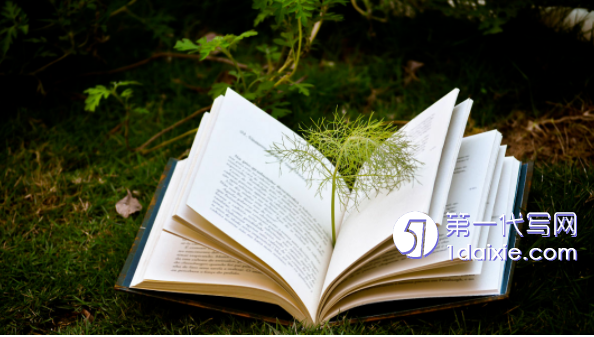本文是一篇英语论文,本文将运用文本细读的方法,透过物质生态批评的视角解读《不存在的女孩》中的物质主体性,以揭示在人类中心主义观念影响下,人与非人类物质所面临的各种危机,阐释水、动物以及海洋生物等非人类物质的能动性。在尾关的作品中,自然物质的施事能力和主体性得到生动体现。
Chapter One The Existential Crisis of Human and Non-human Matter
1.1 Crisis of Non-human Matter

With the rapid development of science and technology, a new era called the Anthropocene emerged. In the Anthropocene era, human activities have a permanent impact on the earth system. Traces of human activity penetrate rocks, ice, or marine sediments. Human becomes a geological process. The novel A Tale for the Time Being shows that the continuous increase of human productivity greatly expands the impact of human beings on the earth system and accelerates the pace of the Anthropocene. Excessive esteem for human beings pushes man to the supreme position of “the beauty of the world, the paragon of animals” (Shakespeare 143), which leads to the separation of man and nature. This kind of anthropocentrism makes non-human nature become the object of exploitation, and human beings gradually become the master of nature, which leads to damage to oceans and animals.
From a narrow perspective, some characters think that the value of nature lies in the fact that it creates and sustains human life, so nature “is instrumental to an active human performance” (Rolston 7). In the novel, a Scotsman and an American regard themselves as an active subject but cannot see the subjectivity of nonhuman matter. In order to meet their needs, they continuously plunder marine ecological resources without restrictions. Eventually, the ocean ecosystem is destroyed.
1.2 Crisis of Human Relations
Some characters in the novel blindly pursue the economic benefits out of non-human matter, while ignoring the emotional connection between humans and makes human relations alienated. In A Tale for the Time Being, the rapid development of science and technology intensifies the contradiction between man and nonhuman nature. When people only care about personal interests and ignore emotional connections, they cause serious social problems. In society, the U.S. military invents a series of weapons of mass destruction. When conflicts of interest arise between nations or between races, the U.S. military resorts to force to solve the problem, which breaks social relations. As the smallest unit of society, the family is inevitably influenced by society. In family relationships, the family should be the most tender place for family members. However, the Yasutanis only see the benefits and ignore the emotions between family members due to the supremacy of interests. As a result, there is a breakdown in family relationships.
In A Tale for the Time Being, capitalist society prospers with the rapid development of industrial civilization. Conflicts arise among big capital because of the competition for economic interests. When there is a conflict between big capital, it is easy to lead to war, resulting in more and more chaos in social relations. In the novel, Ozeki describes the breakdown of social relations during World War II due to technological development and the loss of humanity. Just as Rolston said, “Human desires for maximum development drive population increases, escalate exploitation of the environment and fuel the forces of war. Those who are not at peace with one another find it difficult to be at peace with nature, and vice versa” (333). Those who can’t live in harmony with nature have a hard time getting along with humans, which is mainly reflected in two aspects: First, the Japanese kamikaze pilots had to carry out suicide attacks on American soldiers. The second is that Haruki#1 suffered various cases of abuse in the army.
Chapter Two The Pervasive-Agency of Non-human Matter
2.1 Narrative Agency of Water
The narrative agency means “a nonlinguistic performance of matter manifesting itself often in expressive collectives” (Material Ecocriticism, 30). Material ecocriticism suggests that non-human matter has the ability to generate stories. Material ecocriticism takes matter as “a text, the site of narrativity and storied matter, a corporeal palimpsest in which stories are inscribed” (Iovino & Oppermann, “Theorizing material ecocriticism” 453). The formation process of matter implies “textuality”, which is presented in two ways: “First, the description and representation of non-human matter’s agency in narrative texts; second, the narrative ability of matter as a text gives rise to meanings in interaction” (Iovino & Oppermann, “Material Ecocriticism” 79-80). In other words, during the material-discursive process, matter has the ability to record its own narrative and simultaneously engage in “intra-action.” In A Tale for the Time Being, the water, as a storied matter, can narrate the crimes of the Japanese army during World War II and the interaction of human and nature with its own agency. Besides, water is helpful to heal human spirit.
Water as a subjective being can narrate the story of human interacting with nature. The beach on the tiny Canadian island where Ruth lives is full of trash that has drifted up from the ocean. “The sea was always heaving things up and hurling them back: fishing lines, floats, beer cans, plastic toys, tampons, Nike sneakers. A few years earlier it was severed feet” (Ozeki 6). For humans in the novel, this sea waste is some products. They believe humans narrate the story of water and waste, but nonhuman beings are also exerting their dynamism to tell the relationship between humans and the environment. The sea throwing garbage back on the beach is a narrative of what human beings have done to nature and the destruction of natural environment. Humans dump waste into the sea as if nothing has happened. Little do they know that the sea can narrate their undue behavior, which demonstrates the narrative ability of water. In this sense, water shows that litter in the sea is a symbol of industrialization and capitalism.
2.2 Meaning Generation of Animal
As part of nature, no matter can exist completely separated from other matter but is in a state of “entanglement” in different ways. Barad uses “intra-action,” to denote “the mutual constitution of entangled agencies” (502). In A Tale for the Time Being, the interaction of animals and people is a perfect example of how things entangle with one another. In the process of the intra-action between humans and animals, meaning is created. The death of animals in the forest reflects that the natural system has been violated by humans, and the miserable experience of animal becomes a mirror image of the natural system. According to material ecocriticism, in many cases, “human agency and meanings are deeply interlaced with the emerging agency and meaning of these non-human beings.” (Iovino & Oppermann, “Material Ecocriticism” 83). That is to say that the meaning generation of human agency is closely related to the agency of non-human nature. Therefore, the poisoning of animals also symbolizes the double poisoning of human matter, both physically and mentally.
Like humans, animals belong to the world, and each of them has the right to survive and occupies a place in the natural system. Some humans in the novel view animals as static and passively accepted, they violate other creatures’ rights to survive in order to further satisfy their own interests and egocentric needs. However, non-human beings are intricately entangled with humans. It is worth noting that “to be entangled is not simply to be intertwined with another, as in the joining of separate entities, but to lack an independent, self-contained existence” (Barad ix). That is to say the existence of animal is entwined with humans. As the important part of natural systems, animals generate meaning in their intra-actions with humans. As a result, the miserable experience of animal is the mirror images of the natural system since the harm to animals likewise reflects the harm to the environment.
Chapter Three The Symbiosis of Human and Non-human Matter ........... 43
3.1 Symbiosis with Non-human Matter ............................ 43
3.2 Symbiosis with Human Beings ................................ 45
3.3 Symbiosis with “Material Self” ............................. 48
Conclusion ....................................... 53
Chapter Three The Symbiosis of Human and Non-human Matter
3.1 Symbiosis with Non-human Matter
In Bodily Nature, Alaimo puts forward a concept of trans-corporeality, which is a concept that “stresses the flow of substances and forces linking bodies and environments” and whose ontological, cognitive, and ethical reverberations arise from an “uncomfortable and perplexing place where the ‘human’ is always already part of an active, often unpredictable, material world” (54). As Alaimo said, human beings are deeply entangled in the complex material world. Matter and energy flows between different bodies, connecting matter to each other. That is, human is not the center of the biosphere, but a part of the entangled materializations. As a result, acknowledging the subjectivity and trans-corporeality of human and non-human agent is significant for the symbiosis with the non-human matter.
In A Tale for the Time Being, the Japanese government believes that human beings, the spirits of all things, could take natural resources from it at will. The irresponsible disposal of trash into the water and the brutal slaughter of animals are the main causes of environmental degradation. But in the process of the destruction of nature, some humans in the novel gradually realizes that human beings are also part of nature, and their existence in nature is inevitably subject to the laws of nature. Initially, Japanese staff kill forest crows, capture and kill wolves for human benefit. However, the power of nature is strong, so the actions of human beings are retaliated by nature. In the novel, it is recorded that the people surviving in the city are attacked by owls.

Conclusion
In A Tale for the Time Being, Ruth Ozeki stresses the interconnection between human and nonhuman matters, and she criticizes the arrogance of humans who consider themselves as the center of the universe while considering the nonhuman matter as the passive object. Material ecocriticism breaks down the innate notion that matter is a static object which is passively accepted. Instead, nonhuman matter has inherent power and is dynamic force with generative capacity. The thesis argues that the ignorance of the subjectivity of nonhuman matter can cause the existential crisis of human and nonhuman matter. And the thesis argues that the construction of relationship between human and non-human matter demonstrates the subjectivity of matter and challenges anthropocentrism.
In the novel, the author portrays the existential crisis of human and non-nonhuman matter, which is a result of people’s increasing destruction of the environment during the modernization process. The exploitation of ocean and wildlife on Canada’s small islands is a result of mankind’s limitless access to natural resources for its own benefit. Due to their overzealous pursuit of the economic worth of natural entities, some characters in the novel are in fierce competition with one another in the process of taming nature. Thus, the alienation of man from nature leads to the alienation of human relationships. Events like 9/11, World War II, and Japan’s nuclear wastewater dumping into the ocean affects society. Apart from that, the relationship between the family members also becomes alienated. The spirit is rapidly disintegrating as a result of an overzealous pursuit of matter’s economic value. This thesis argues that the existential crisis of human and non-human matter is rooted in anthropocentrism. Anthropocentrism views humans as subjective beings but ignores the subjectivity of non-human nature, which has led to the destruction of the natural environment on which humans and non-humans depend, and caused a serious existential crisis of human and non-human matter.
reference(omitted)
